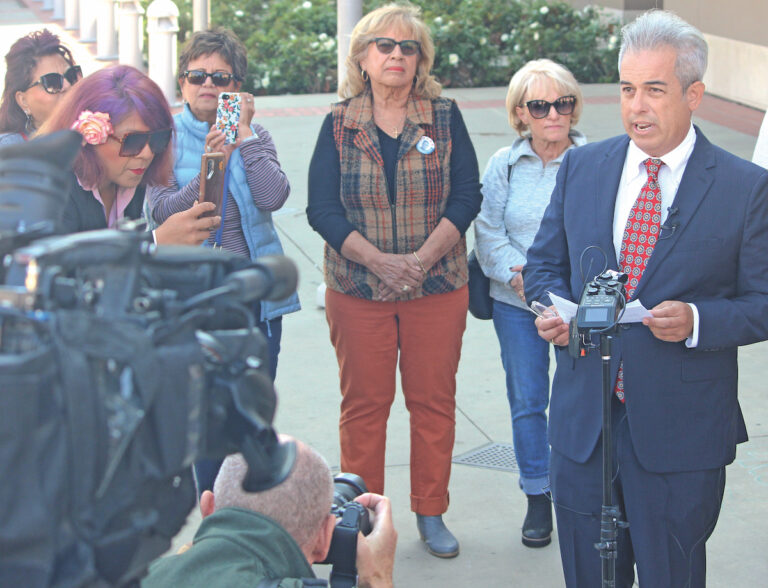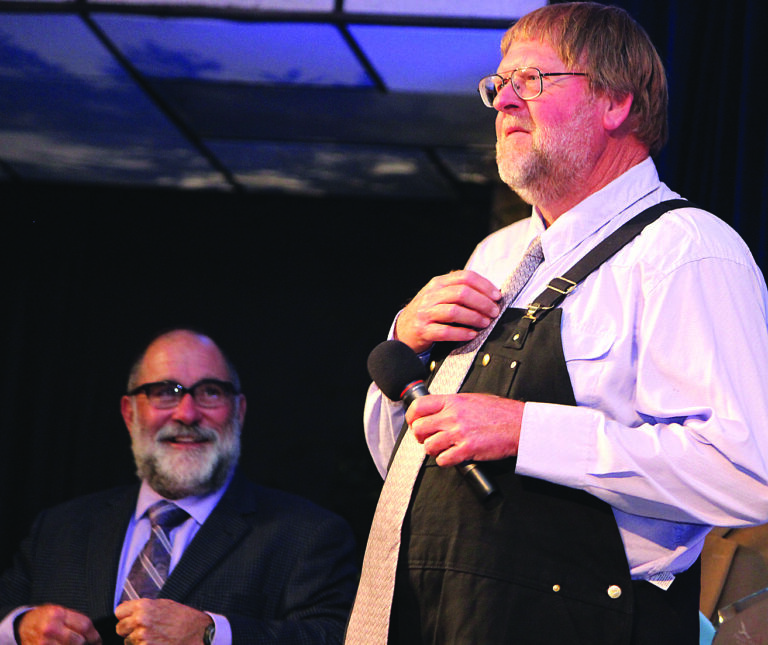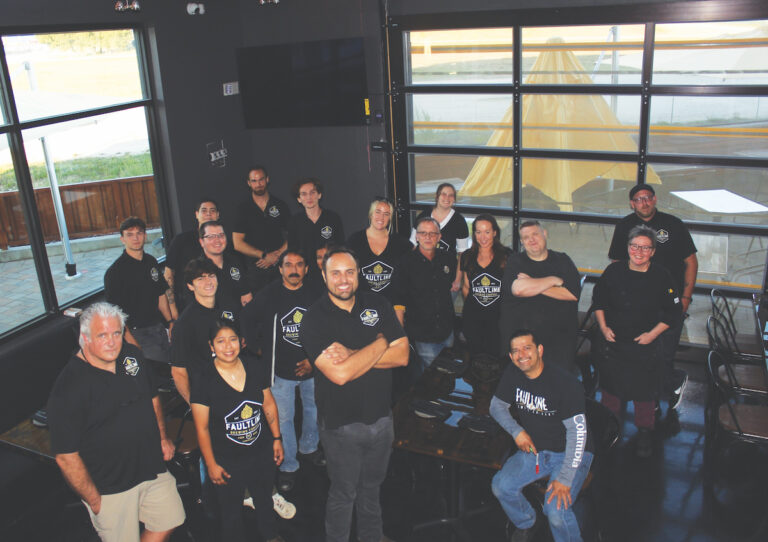ARTS AND MUSIC
ATMOSPHERE WITH BLIMES & GAB AND PLAIN OLE BILL DJ and producer Ant and rapper Slug make their own rules as they go. For over two decades, the revered and prolific Minnesota duo Atmosphere has sustained a laborious yield, releasing over two dozen studio albums, EPs, collaborations and side projects. The outfit’s 2007 acclaimed Strictly Leakage was released as a free internet download—an out-of-nowhere gift to fans fueled by perpetual-mix stamina. The release complemented the three EPs Slug had dropped six months before. New material has been coming in meaningful droves: Last October, Atmosphere released WORD?, featuring “Barcade,” which includes a guest spot from Aesop Rock and a posthumous verse from MF Doom. The 14-track record debuted at No. 4 on Billboard’s Top R&B/Hip Hop Albums chart and has over five million streams on Spotify. $34.50/$38 plus fees. Friday, Oct. 14, 8pm. The Catalyst, 1101 Pacific Ave., Santa Cruz. catalystclub.com.
PUNKTOBERFEST 2022 This eight-band punk-o-rama might not be strictly punk rock, but that makes it even more punk. Sacramento’s The Seafloor Cinema’s description might have your brain spinning a bit: A blend of “midwestern emo, pop-punk and math rock?” Yup. You will have to hear for yourself. Coming down from San Jose, the Trim is more straightforward ’90s Brit-pop a la The Cure. Dallas’ Lil Lotus is a pop-punk revivalist who’s unafraid to veer off in any direction that moves him—he grew up playing in metalcore bands, then went solo acoustic until he was introduced to emo-rap. (Whatever the hell that is). Lotus’ Epitaph Records debut ERRØR BØY is quickly gaining traction. Unwell, Pomi, Goldview, Summon the Hero and Bareknuckle. Round out the eclectic night of music in the Santa Cruz Mountains. $30/$35 plus fees. Saturday, Oct. 15, 5pm. Felton Music Hall, 6275 Hwy 9, Felton. feltonmusichall.com.
GRATEFUL SHRED Los Angeles’ Grateful Shred happened by accident. And they’re not “just another fucking Dead tribute band. We’re more of a take on the Dead,” says bassist Dan Horne. In addition to Horne (Cass McCombs, Jonathan Wilson), Sam Blasucci and Clay Finch (of country-folk revivalists Mapache) handle vocals and guitar and there’s a rotating cast of drummers and keyboardists. Grateful Shred doesn’t play facsimiles; this group of musicians is simply having fun, rocking the music they enjoy playing. Their vibe, their spirit, their authentic adoration for the songs are infectious. “Strangely enough, in a world overflowing with wax museum nostalgia and Deadly sentimentalism, we need the Shred, now more than ever.” $32/$37 plus fees. Saturday, Oct. 15, 8pm. The Catalyst, 1101 Pacific Ave., Santa Cruz. catalystclub.com.
HOT BUTTERED RUM With THE LO-TIMERS Hot Buttered Rum is the only band who can say they are the “Official Bluegrass Band of the 2014 World Champion San Francisco Giants.” For over two decades, the group has seamlessly interlaced bluegrass, folk, jazz and soul into an original iteration of spellbinding Americana. Part dance party, part Appalachia roots, HBR came to be in the High Sierra backcountry and San Francisco basements. On the heels of their 2022 release Shine All Night the band continues to tour nonstop. The Lo-Timers, meanwhile, are string pluckers building a repertoire of original western-centric tunes. $20/$25 plus fees. Saturday, Oct. 15, 9pm. Moe’s Alley, 1535 Commercial Way, Santa Cruz. moesalley.com.
INSECT SURFERS WITH FASCINATING CREATURES OF THE DEEP AND DEAD KAMPERS The self-proclaimed “planet earth’s longest-running modern surf band,” the Insect Surfers formed over 40 years back in Washington D.C., with David Arnson at the helm—they’ve been based out of Los Angeles since the mid-1980s. Inspired by the psych surf sounds of the ’60s, their tight instrumentals are propelled by Agent Orange-flavored punk. The two Santa Cruz bands who are opening—Fascinating Creatures of the Deep and Dead Kampers—are perfect fits for a bill saturated in surf rock. $15. Saturday, Oct. 15, 8pm. The Crepe Place ,1134 Soquel Ave., Santa Cruz. thecrepeplace.com.
ZERO In 1980, Steve Kimock joined the Grateful Dead’s Keith (keys) and Donna Jean Godchaux’s (backup vocals) Heart of Gold Band, featuring drummer Greg Anton. Sadly, Keith didn’t make it to Zero’s Zenith. Initially an all-instrumental band, the dynamic changed after Dead lyricist/poet Robert Hunter convinced them to add vocals with lyrics he’d provide. The reimagined Zero performed a three-night run at the Great American Music Hall in 1992, unleashing their barrage of new songs outfitted with Hunter’s majestic prose—master sound director Dan Healy was on board to record them. The result was Chance in a Million. Zero has played 1,300 shows and dropped nine albums, including their 2022 Naught Again. In addition to Anton, the all-star lineup includes Steve Kimock, Pete Sears, Spencer Burrows and Hadi Al-Saadoon. $34/$45/$49 plus fees. Sunday, Oct. 16, 8pm. Felton Music Hall, 6275 Hwy 9, Felton. feltonmusichall.com.
‘MY NAME IS ANDREA’ Considered one of the most radical and controversial writers of the 20th century, Andrea Dworkin’s analysis of male supremacy with a singular, apocalyptic urgency has been dubbed as “revolutionary” by many scholars. The “hybrid feature documentary” uses Dworkin’s personal experiences of sexual assault to develop “epic concepts around what it means to be a woman.” The film intertwines rare archival footage of Dworkin with visceral dramatizations performed by Amandla Stenberg, Soko, Andrea Riseborough, Ashley Judd and Patti LuPone. Detested and fiercely critiqued in her time, Dworkin’s commanding voice speaks vibrantly to contemporary movements like #MeToo. My Name is Andrea was written and directed by award-winning filmmaker Pratibha Parmar, who will be on hand during the screening. Free with registration (donations appreciated). Tuesday, Oct. 18, 7pm. Del Mar Theatre, 1124 Pacific Ave., #4415 Santa Cruz. mynameisandreamovie.com.
COMMUNITY
KAREN MACNEIL: ‘THE WINE BIBLE, THIRD EDITION’ $168,000. That’s the price tag of all the wines combined that Karen MacNeil tasted for her latest edition of the well-respected Wine Bible, which features new chapters on Great Britain, Croatia, Israel and a new section called “In the Beginning…Wine in the Ancient World.” The “Great Wines” section—formerly “Wines to Know”—features expanded chapters on France, Italy, Australia, South America and the U.S. There are also updated glossaries and a prolonged “Mastering Wine” section that incorporates the latest science on taste and smell. $5-45. Thursday, Oct. 13, 7pm. Soif Wine, 105 Walnut Ave., Santa Cruz. bookshopsantacruz.com.
WORLD ARTS FEST 2022 Join in and celebrate Santa Cruz’s abundant cultural diversity. The festival includes performances by Arnaud Loubayi, Dandha da Hora, John and Nancy Lingemann, Antara Asthaayi Dance, Raizes do Brasil Capoeira, Senderos, Elie Mabanza, DJ Monk Earl, Ukrainian STEPPE and more. There will also be an assortment of artisans and vendors selling crafts, wares and food. Free. Saturday, Oct. 15, noon-5pm. Tannery Arts Center, 1050 River St., Santa Cruz. tanneryworlddance.com.
GROUPS
EARTH SISTERS It might initially sound like hippy-dippy nonsense, but Earth Sisters’ nature and dance-based journey of “self-discovery, purpose, sisterhood and rite of passage” is the real deal. The collective aims to provide a transcendental experience for 17-20-year-old women. This opportunity offers support and guidance to young women transitioning from adolescence to adulthood. Earth Sisters meet twice monthly with day-long outdoor adventures, dances, sharing and fire circles and full moon hikes. $495-795 (scholarships available). Wednesday, Oct. 12, 6-8:30pm. Moore Creek Preserve, Moore Creek Trail, Santa Cruz. thriveyoungleaders.com/earth-sisters.
WOMENCARE ARM-IN-ARM Led by Sally Jones and Shirley Marcus every Monday, the longtime group for women with advanced, recurrent or metastatic cancer is a safe place for those going through similar hardships to find support in one another. Free (registration required). Monday, Oct. 17, 12:30pm. WomenCare, 2901 Park Ave., A1, Soquel. 831-457-2273. womencaresantacruz.org.
OUTDOORS
SANTA CRUZ KIDS IN NATURE The Santa Cruz Kids in Nature Program is an outdoor-based nature club for children with core curriculums revolving around social and emotional learning, natural and cultural history and social justice. The grassroots outfit focuses on encouraging creativity, confidence, communication skills, community, ecological stewardship, curiosity and more. Email ki*****************@***il.com about pricing and scholarships. Wednesday, Oct. 12–Friday, Oct. 15; Monday, Oct. 17 and Tuesday, Oct. 18, 2:45-5:15pm. 1156 High St., Santa Cruz. kidsinnaturesc.com.
Email upcoming events to Adam Joseph at least two weeks beforehand.
Or, submit events HERE.

























